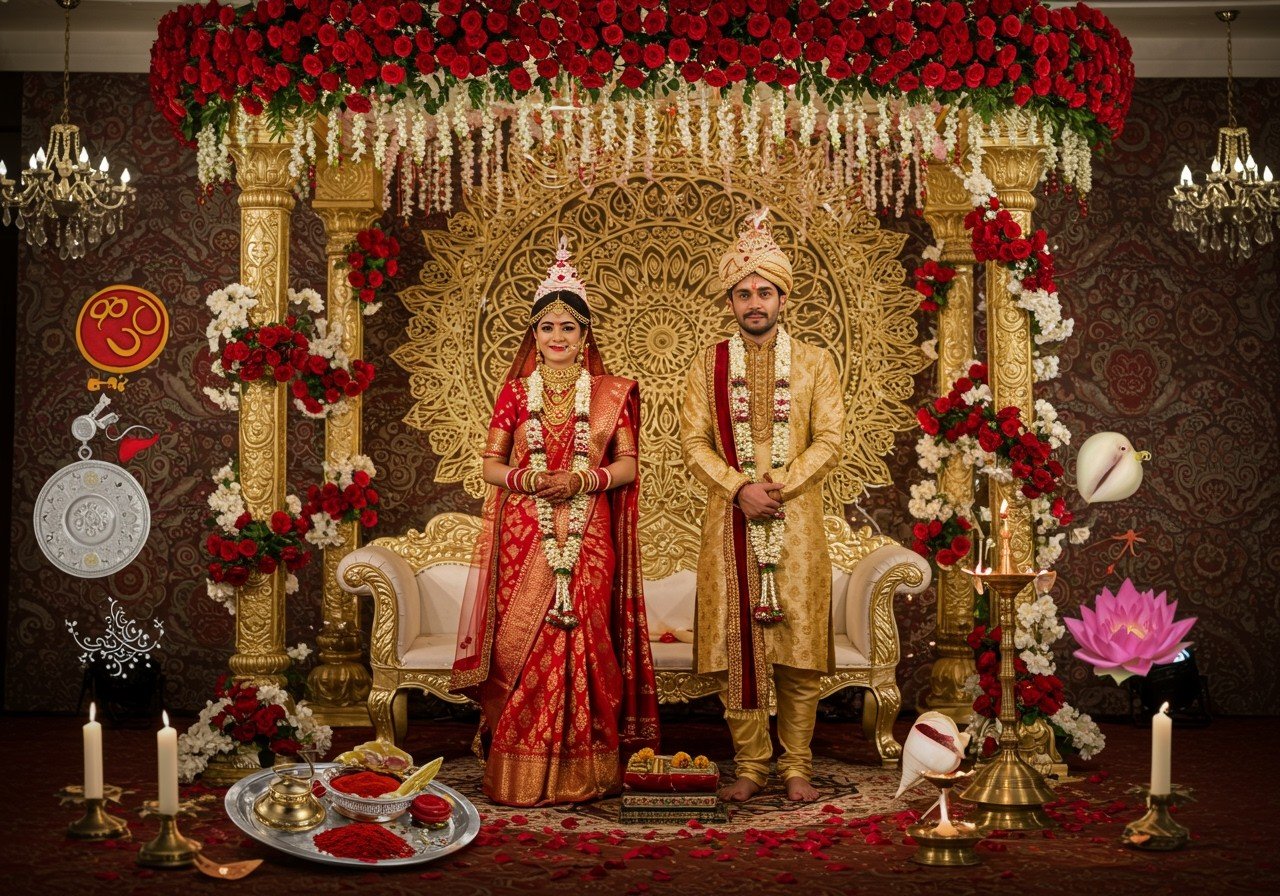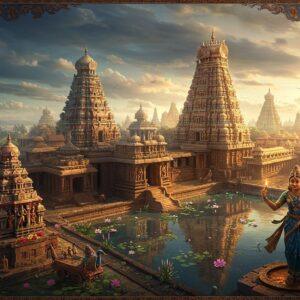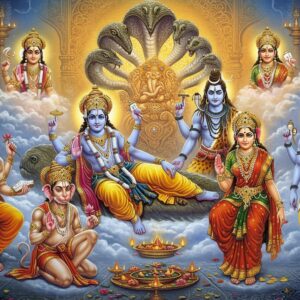
Bengali weddings are a beautiful tapestry of traditions, rituals, and cultural nuances passed down through generations. As we step into 2025, we see a harmonious blend of these time-honored customs with modern conveniences, creating a truly unique and memorable celebration. This guide delves into the heart of Bengali Hindu wedding rituals, exploring the significance of each ceremony and the evolving roles of the bride and groom in contemporary society.
Pre-Wedding Festivities: Setting the Stage for a Sacred Union
The journey to marital bliss begins with a series of pre-wedding rituals that prepare the couple and their families for the sacred bond they are about to create.
- Adan Pradan: This initial meeting between the families isn’t just about setting the date; it’s about laying the foundation for a harmonious relationship between two families, fostering a sense of unity and mutual respect.
- Aashirbaad (Blessings): More than just an engagement, the Aashirbaad ceremony showers the couple with blessings and gifts. Families exchange tokens of love and well wishes – gold jewelry, beautiful clothes, sweets, and auspicious items like fish, betel leaves, and curd – symbolizing prosperity and happiness in the journey ahead. Find perfect Aashirbaad gifts at Poojn.in.
- Aiburobhaat (The Last Feast): This poignant ritual celebrates the bride or groom’s last meal as an unmarried individual, a bittersweet moment filled with love, laughter, and delicious traditional Bengali cuisine. Fish, a symbol of prosperity, often takes center stage in this celebratory feast.
- Ganga Nimantran (Inviting the Ganga): A symbolic invitation to the holy River Ganga, this ritual involves a reverent procession to the riverbank to collect sacred water, purifying and sanctifying the wedding ceremonies to come.
- Dodhi Mangal (Morning Ritual): The wedding day begins with a simple yet significant meal of soaked flattened rice with yogurt. It marks the start of the couple’s wedding day fast, a symbolic gesture of purification and devotion.
- Nandi Mukh (Honoring Ancestors): With respect and gratitude, the couple pays homage to their ancestors, seeking their blessings for a happy and prosperous life together. This tradition reinforces the importance of family lineage and heritage.
- Gaye Holud (Turmeric Ceremony): The vibrant Gaye Holud ceremony fills the air with joy and laughter as turmeric paste is applied to the bride and groom. This ritual, more than just a beauty treatment, signifies purification and blessings, preparing them for their new life together.
- Sankha Pola (Conch Shell and Coral Bangles): Adorning the bride’s wrists, the Sankha Pola bangles represent her marital status. These beautiful adornments, a quintessential part of Bengali bridal attire, symbolize her journey into married life.
The Wedding Day: A Sacred Union
The wedding day unfolds with a series of sacred rituals, each carrying deep cultural and spiritual significance.
- Bor Boron (Welcoming the Groom): The groom’s arrival is met with a warm welcome by his future mother-in-law, who offers him sweets and water amidst the auspicious sounds of conch shells and ululation. The bride’s father then presents the groom with new clothes (Bostro) and a gold ring, signifying acceptance and blessings.
- Saat Paak (Seven Circles): The bride, seated on a pidi (low wooden stool), is carried around the groom seven times by her brothers. This beautiful tradition symbolizes the intertwining of their lives and the strong bond they are forging, a promise of togetherness through thick and thin.
- Subho Drishti (First Glance): A moment of anticipation and joy, the Subho Drishti is when the bride lowers the betel leaves shielding her face and gazes upon her groom for the first time. This tradition marks their first shared glance as a couple.
- Mala Badal (Exchanging Garlands): The exchange of garlands, not once but thrice, signifies their acceptance of each other and the mutual commitment they are making. This vibrant tradition marks a public declaration of their love and intention to marry.
- Sampradan/Kanyadaan (Giving Away the Bride): A poignant and emotional moment, the Kanyadaan ceremony is when the bride’s father gives her hand to the groom, their clothes tied together in a holy knot. This symbolizes the transfer of responsibility and the groom’s promise to cherish and protect his bride.
- Yagna (Sacred Fire): The couple circumambulates the sacred fire (Agni) seven times, reciting vows and solidifying their commitment. The Yagna represents the divine witness to their union.
- Saptapadi (Seven Steps): As they walk around the Yagna fire seven times, the couple steps on betel leaves and pushes grinding stones, signifying the shared responsibilities and the journey they will embark on together.
- Anjali/Onjoli (Offering Puffed Rice): Offering puffed rice to the sacred fire is a prayer for prosperity, happiness, and a blessed life together. This symbolic act seeks divine blessings for their future.
- Sindoor Daan (Vermilion Ceremony): The groom applies sindoor to the bride’s hair parting, a symbol of her marital status. He then covers her head with a new saree (Lajja Bastra), marking her transition into this new role. Looking for premium sindoor for this special moment? Explore Poojn.in’s collection.
Post-Wedding Rituals: Embarking on a New Journey
The wedding celebrations continue with post-wedding rituals that mark the beginning of the couple’s life together.
- Bashor Jaaga/Ghar (Night of Fun): The night following the wedding is filled with laughter, games, and playful banter as family and friends celebrate the newlyweds. This joyous occasion strengthens bonds and creates lasting memories.
- Biday/Farewell: A bittersweet moment filled with emotion, the Biday ceremony is when the bride bids farewell to her family. As she leaves, she throws rice over her head, a symbolic wish for prosperity and happiness for her maternal home.
- Bou Boron (Welcoming the Bride): The bride is warmly welcomed into her new home. She steps into a tray of alta (lac dye) and milk, leaving auspicious red footprints, symbolizing the arrival of Lakshmi, the goddess of prosperity and good fortune.
- Kaal Ratri (Night of Separation): On the second night after the wedding, the bride and groom do not see each other, a traditional practice observed for various reasons.
- Bhat Kapod & Bou Bhat (Meal Rituals): Bhat Kapod symbolizes the groom’s commitment to providing for his bride, while Bou Bhat, a reception hosted by the groom’s family, introduces the bride to her new relatives and friends. She prepares and serves a meal, a gesture of love and respect.
- Phool Sajja (Floral Decoration): The couple’s bed is adorned with flowers, creating a romantic ambiance. They share puffed rice (khoi) with sweet yogurt, symbolizing a sweet and harmonious start to their life together.
- Dwiragaman (Return to Bride’s Home): The newlyweds visit the bride’s home, a joyous reunion filled with love and warmth. This visit strengthens family ties and marks the continuation of their bond.
Essential Wedding Items at Poojn.in
For a truly authentic Bengali wedding experience, Poojn.in offers a wide selection of traditional items. Find everything you need, from beautifully crafted Topor Mukut sets to pure cotton Gamchas and complete Puja Samagri kits. We also offer exquisite Topor Mukut sets handcrafted in Balurghat, ensuring authenticity and quality. Explore our collection today.
Bengali Hindu Matrimony in 2025: A Blend of Tradition and Modernity
Bengali Hindu weddings in 2025 continue to honor age-old customs while embracing modern sensibilities. These celebrations are not just about rituals; they’re about bringing families together, celebrating love, and upholding cultural heritage. As families engage in these timeless practices, they also find ways to personalize them, creating a unique expression of their love story.
With the convenience of online shopping at platforms like Poojn.in, families can easily find authentic ritual items, ensuring that each ceremony is conducted with utmost respect and authenticity. Poojn.in provides a convenient and reliable platform to source high-quality Topor Mukut sets and other essential items, adding a touch of modern convenience to traditional celebrations.


